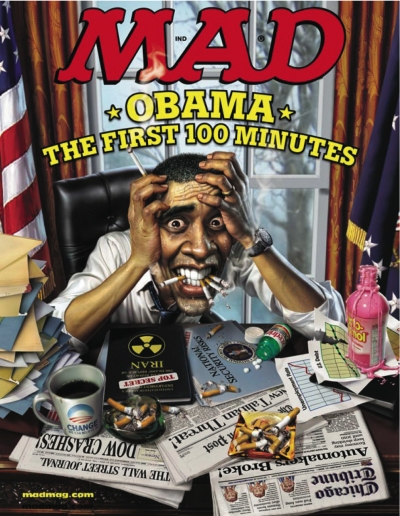

The mood of the country is grim and fearful, as big companies lay off tens of thousands.
I bought three rose bushes today, and as is my habit these days, I asked the sales clerk at the plant nursery how business was doing. She said it's been bad: "people are scared." When people are scared, I guess they don't buy flowers. But she said people are buying lots of vegetables for their gardens!
The state of California is broke, unable to pass a budget, and the University of California is starting to get hit with cutbacks. Nonetheless, I have enough confidence to buy 30 bucks worth of roses:
I found out at the last minute, just as I was waiting for my ride to come. I was given a choice of taking an earlier flight or one leaving the next day.
After a brief spell of agonizing indecision, I realized it would be unlikely I could get to the airport in time for the earlier flight. So, I decided to wait for the next one. So, Chris and I were doomed to miss the first day of the 2-day workshop. I emailed our host, Chenchang Zhu, and she kindly rescheduled our talks for the second day.
On Wednesday our flight left uneventfully from Los Angeles. I fell asleep as soon as possible, and got 6 hours of sleep. Unfortunately our flight was a bit late to Heathrow, so we missed our connection to Frankfurt. The next flight to Frankfurt left about 3 hours later, and arrived after the last train to Göttingen. I'd known all along that catching this train would be a close call, so we'd planned for this eventuality: we spent the night in a hotel next to the airport.
At 6:42 the next morning — i.e. today, Friday — we took a train to Göttingen. From then on, things got better. On the train ride we talked about some cool new math ideas. We easily found our way to the legendary mathematics institute in Göttingen, which was the world headquarters of math back in the days of Hilbert until the Nazis took over. I gave my talks and Chris gave his. We'd missed the talk of my student Alex Hoffnung on the previous day, and some talks by Ieke Moerdijk... but apart from that everything was great. The audience asked lots of interesting questions.
Here are some photos of my talk and the dinner later that night, taken by Nadja Kutz:
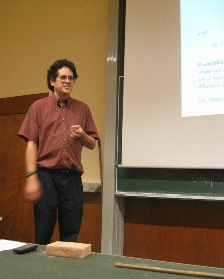
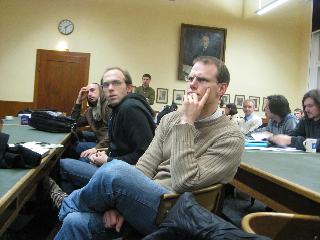
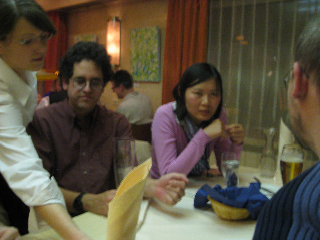
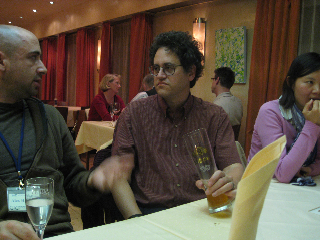
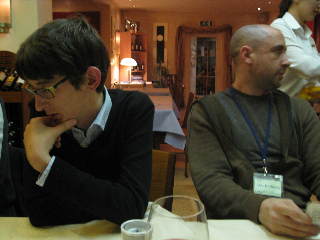
February 7, 2009
Today a bunch of us walked around town and saw the sights, most notably
Gauss' tomb:

February 12, 2009
It's Darwin's 200th birthday! There was an interesting radio
show about why he took so long to publish. He may have done it
for love... and he may have finally gotten up the nerve to
publish after his daughter died. I guess nobody really knows,
but it's fun to speculate:

February 13, 2009
It would be really interesting if this theory turned out to be true...
but I'm not betting on it, yet:
Something dramatic happened about 12,900 years ago, and the continent of North America was never the same. A thriving culture of Paleo-Americans, known as the Clovis people, vanished seemingly overnight. Gone, too, were most of the largest animals: horses, camels, lions, mammoths, mastodons, saber-toothed cats, ground sloths and giant armadillos.A more traditional theory is that the Clovis people killed off the North American megafauna. This is called the "Pleistocene overkill hypothesis", and I talked about it here on December 10, 2006. There are lots of reasons to be skeptical of the new theory — read more of the above article to see some.Scientists have long blamed climate change for the extinctions, for it was 12,900 years ago that the planet's emergence from the Ice Age came to a halt, reverting to glacial conditions for 1,500 years, an epoch known as the Younger Dryas.
In just the last few years, there has arisen a controversial scientific hypothesis to explain this chain of events, and it involves an extraterrestrial calamity: a comet, broken into fragments, turning the sky ablaze, sending a shock wave across the landscape and scorching forests, creatures, people and anything exposed to the heavenly fire.
Now the proponents of this apocalyptic scenario say they have found a new line of evidence: nanodiamonds. They say they have found these tiny structures across North America in sediments from 12,900 years ago, and they argue that the diamonds had to have been formed by a high-temperature, high-pressure event, such as a cometary impact.
St. Louis, MO — In the wake of the Chinese government's destruction of one of its retired satellites in orbit last year, scientists are increasingly concerned that space debris poses a significantly greater risk to satellites than previously believed. Indeed, scientists at a recent American Physical Society meeting in St. Louis said they fear the chances of a destructive "supercritical chain reaction" collision in space are increasing.Presumably this sort of chain reaction becomes inevitable after the density of satellites exceeds a certain threshold, unless people can get satellites to dodge junk, or set up some system for debris removal. Is anyone suggesting treaties to keep the density of satellites below this threshold?Scientists have long been concerned about debris in space, particularly in the band between 500 to 600 miles above Earth, where many other satellites orbit. Space debris is also a problem in the lower orbits around 200 miles up, typically used by the Space Shuttle.
One phenomenon that scientists fear is the supercritical chain reaction, in which a collision between two pieces of debris creates more pieces that then collide with other debris. The result is a slow cascade of collisions that breaks existing debris into thousands of smaller pieces. Each one of those pieces poses a threat to orbiting satellites. This chain reaction problem, said David Wright, codirector of the global security program for the Union of Concerned Scientists, "is worse than assumed."
In January, 2007, the Chinese blew up the defunct satellite, Feng Yun-1C, with an anti-satellite missile, creating a cloud of debris in space. Scientists studied the explosion and determined that the NASA Standard Breakup Model used to predict the amount of debris produced by a collision underestimated the actual number by a factor of three.
In addition to the explosion occurring in the most crowded orbital zone, Wright said that because of extremely low atmospheric density at that altitude the pieces of the Chinese satellite may linger for decades before falling into the lower atmosphere and burning up.
The Chinese explosion made what was already a bad problem worse. A 2006 study by NASA scientists published in the journal Science suggested that the number of pieces of debris would continue to grow for the foreseeable future. The study based its predictions only on items in orbit at the time.
While gravity and atmospheric drag remove pieces of debris from orbit, the process is slow. In a supercritical chain reaction, collisions create more debris than those forces remove, causing the amount of debris to build up and increasing the likelihood of collisions.
Previous research has shown that a particle of the right size scoring a direct hit on a 10-ton satellite in low-earth orbit would double the amount of debris presently in the band. Now, said Wright, "the Chinese test suggests that [the impact] would be even bigger."
For more, try Orbital Debris Quarterly News.
February 16, 2009
Yesterday the second of three storm systems rolled into California.
By today, snow blanketed the more mountainous parts of the state:
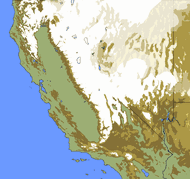
See those tiny white spots near the southernmost part of this picture? Those are some mountains we can see from here. They're expecting 18 inches of snow up there today. Here it's raining. When the clouds clear up, the mountains will be beautiful.
Last night we stayed home and I made a pot roast for dinner. I
support vegetarianism for many reasons, but on a cold wet windy night
something in me still enjoys slowly cooking meat over a flame.
It's the vegetables, though, that make the pot roast smell good:
garlic, onions, leeks, carrots and turnips!
February 19, 2009
After staying awake for 45 hours, the California Senate finally
passed a budget for the state. It was months
overdue, and our state had started laying off employees and handing out
IOUs instead of checks where money was due. It was an enormous game of
chicken between the Democrats and Republicans, with the Republican
governer Arnold Schwarzenegger eventually siding with the Democrats
in their demand to raise takes... a story too complicated and sordid
for me to retell here, with a
dramatic ending.
Lots of things will happen now, few of them pleasant.
To confront the $42 billion dollar shortfall, the
new budget raises taxes by $12.5 billion, cuts $14.8 billion
in spending, borrows $5.4 billion and relies on $7.8 billion in
federal stimulus funds. Those numbers don't add up to $42
billion, but hey! — that's okay as long as nobody knows
how to add. And fewer people will! Funding for kindergarten through
12th-grade public education will be cut by $4.8 billion, on top of
this year's $400 million cut. That means $750 less per student per
year. The University of California, where I work, and California State
University will also each suffer a 10 percent budget cut.
February 20, 2009
My neighbor Sarah
Simpson picked me up and drove me to work.
She was going to pick up her husband and take her kids up to the
mountains to see the snow.
She's a contributing editor at Scientific American who specializes in earth sciences. Her husband, Tim Lyons, is a professor of biogeochemistry at UC Riverside. He works on the early history of the Earth's climate. Sarah said lately he's been spending a lot of time in Oman. I didn't get a chance to ask why, since I had to jump out and go teach my class.
I'd picked up a free local newspaper sitting in my driveway right before Sarah picked me up. Waiting for class, I gave it a look. The headline was "Professor Finds Evidence of Oldest Animals". It was about Gordon Love, who also works in biogeochemistry at UCR. He too has been spending a lot of time in Oman. He found rocks containing traces of chemicals that suggest the presence of sponges dating between 750 and 635 million years ago — the chilly period known as "Snowball Earthquot;. These would be the oldest known multicellular organisms!
For details, read this:
The Federal Reserve is the US government-run banking system established in 1913 in response to the panic of 1907, when the stock exchange dropped 50% and there was a run on banks. If you haven't read about the panic of 1907, now is a good time.
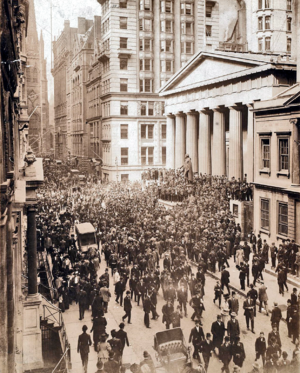
The following graph shows how much money US banks borrowed from the Federal Reserve between 1919 and December 2007. Note that the top of the scale is $10 billion. The sharp spike is the savings and loan crisis at the end of the 1980s:
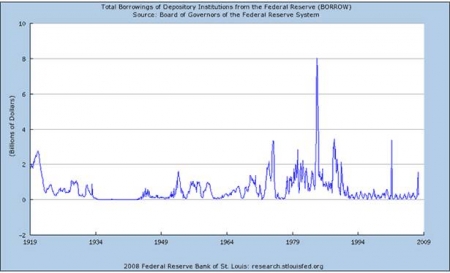
The second graph shows the same thing during the period between 1919 and November 2008. Now the top of the scale is $800 billion, and all the ups and downs of earlier eras are dwarfed by the crisis we're in now:
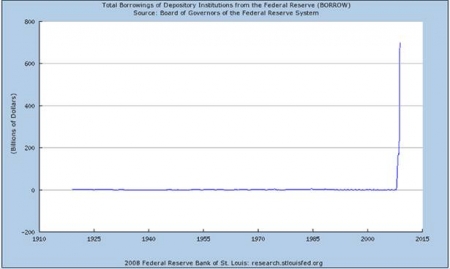
February 22, 2009
On this diary I talk a lot about the drought in California.
If you live somewhere where it rains a lot you may think that's just
a reflection of my overall nervousness about climate change, but it's
not just that. The drought has been going on for years. It's real.
And despite the delightful rains we've had last week, it's so bad
that farmers in the Central Valley — the big valley that
produces a quarter of all the food grown in the US — may
not get any water this summer. On top of the general economic
crisis and the special problems faced by
California, this will really hurt. But it's something
we need to get used to: the southwest United States is probably
headed for a permanent drought, as discussed
in my April 6th, 2007 diary
entry.
Many farmers in the state's agricultural heartland will get zero water
allocations this year because of drought, a problem that will likely spur
more fallowed and abandoned fields, tens of thousands of job losses and
higher food prices, officials said Friday.
It is the first time the U.S. Bureau of Reclamation expects to provide no
water to its agricultural customers in the San Joaquin Valley, said Donald
Glaser, regional director of the bureau's mid-Pacific region. The allocation
can be re-evaluated and increased if the state has a very wet spring, but
that is not expected to happen.
Last year's allocation was 40 percent. The previous low, during the last
drought in the early 1990s, was 25 percent. The growing region, which includes
Stockton, Fresno and Bakersfield, produces a quarter of the nation's food
supply.
"There will be as much as a million acres of land in the Central Valley that
will not receive water," Glaser said at a news conference in Sacramento.
"This is going to be a tough year."
Farmers will cut back on production, which "is going to have a ripple affect
through the economy. Food's going to go up, they don't need as much labor,
they don't need as many supplies, fuel, tractors, trucking, boxes, pallets,"
said Steve Pastor, executive director of the Riverside County Farm Bureau.
California's agriculture is a $36.6 billion a year industry.
Richard Howitt, chairman of the UC Davis Department of Agricultural and
Resource Economics, has said water deliveries of 15 percent of full allocation
could cause the loss of 40,000 jobs in California and $1.15 billion in farm
and related income.
The Bureau of Reclamation administers the Central Valley Project, fed by
Northern California reservoirs that are at historic lows. The project also
supplies residents and industry in the San Francisco Bay area and wildlife
refuges, which all will get 50 percent to 75 percent of their allotments.
The allocations are based on predictions of snowpack runoff into Shasta
Reservoir, which is at about one-third of capacity. If the runoff is
greater than expected, agricultural users would get a 10 percent
allocation and other users would get 60 percent to 100 percent, Glaser said.
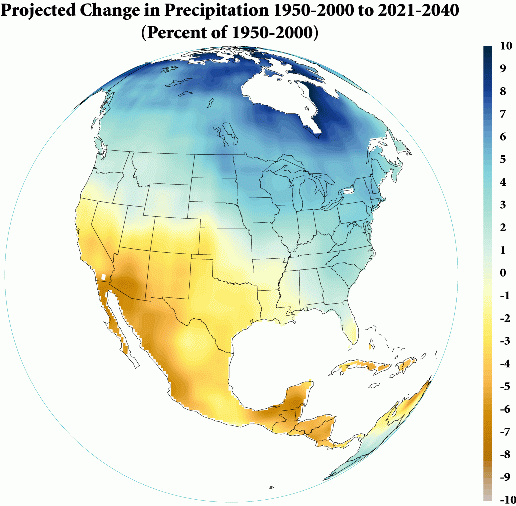
Central Valley Farmers Told No Water Will be Delivered This Year
Janet Zimmerman
Riverside Press-Enterprise
Feburary 21, 2009
February 23, 2009
Some good news for a change. The air in Southern California
is getting better! Trucks bringing in goods from the ports clog
our highways, and they're a big part of why the air is so bad.
Finally someone is doing something about it.
Cleanup at the ports of Los Angeles and Long Beach begins to pay off
Ronald D. White
Los Angeles Times
February 23, 2009
An ambitious plan to clean up once-filthy air around the ports of Los Angeles and Long Beach has shifted into high gear.
Hundreds of 1988-and-older trucks have been banned since October. Others that don't meet 2007 air pollution standards began paying a $70 fee last week each time they haul cargo to and from the ports. This week, the first of a fleet of electric trucks will debut. And within three years, most ships will be able to plug into the ports' electrical grid and turn off their exhaust-belching diesel engines.
For more than a decade, South Bay and Long Beach residents have complained about pollution from the ports, and 1,200 annual premature deaths have been linked to the ports' air pollution problems. But in October, the ports launched the cleanup, and it's beginning to pay off.
"This is the No. 1 health issue in our city," said Long Beach Mayor Bob Foster, who was pleased with the new truck fees introduced last week. "By paying these fees, the people who benefit from the goods-movement industry have become part of the solution to cleaning the air."
Los Angeles Mayor Antonio Villaraigosa agreed. The new fee collection "marks a milestone in our efforts to clean up the ports as we roll ahead with taking 16,800 dirty-diesel trucks off the road for good."
The National Resources Defense Council, long one of the ports' toughest critics, was impressed. It praised the step in October to remove about 2,000 trucks that were at least 20 years old. As a result, the group estimated that diesel particulates emissions may have been reduced 50%.
I've been frantically trying to finish up a paper with Mike Stay in time for an end-of-the-month deadline. We've been working on this paper for years! The tough part was finding and then nicely explaining a programming language suitable for quantum computation. Once this is done — and it will be done this weekend — he can move ahead on his thesis, which will be about 2-categories and computation. After going broke as a math grad student at UCR (he has a family to support), he took a job at Google, but he's going to get a PhD in computer science at the University of Auckland, where he got his master's, with me as one of his thesis advisors.
Some books I'd like to read if I had time. These are the latest offerings from the University of California Press:
My friend Oz pointed me to this nice picture from NASA:
On Tuesday February 24th, cold winds coming down from Greenland collided with moist air over the Greenland Sea, forming wonderfully regular rows of clouds called "cloud streets". When these hit the island of Jan Mayen, they formed a string of eddies called a von Kármán vortex street. If you look carefully you can see the same phenomenon when water in a stream flows past a protruding rock!
The NASA picture is incredibly detailed. Here's a blowup:

We could use some of those clouds down here in California, where Governor Schwarzenegger declared a state emergency today.
February 28, 2009
A fun story in yesterday's Los Angeles Times: an octopus in
the Santa Monica Pier Aquarium figured out how to flood the place.
From the war of nature, from famine and death, the most exalted object which we are capable of conceiving, namely, the production of the higher animals, directly follows. There is grandeur in this view of life. - Charles Darwin
© 2009 John Baez
baez@math.removethis.ucr.andthis.edu